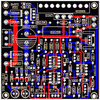I've checked every solder joint and touched any that didn't look perfect with the tip of the soldering iron to make sure. They are all nice & shiny.
VD2 tests OK according to my meter. I checked several times to make sure and it is consistently 0.644V in one direction and 0V in the other.
If it was in backwards I would expect the red light to turn on every time I turn it on but that isn't the case. It is correct according to both the drawing and the marking on the board too.
BTW: The output of OP1 isn't always -4.1V. If I turn the voltage all the way down before turning the power on the output of OP1 varies between 0.04V and 22.66 (most of the time)
And just to make you happy I replaced R8 with a 1.5KΩ with the other end tacked to the end of R5 (= -5.1V ). It made absolutely no difference.
VD2 tests OK according to my meter. I checked several times to make sure and it is consistently 0.644V in one direction and 0V in the other.
If it was in backwards I would expect the red light to turn on every time I turn it on but that isn't the case. It is correct according to both the drawing and the marking on the board too.
BTW: The output of OP1 isn't always -4.1V. If I turn the voltage all the way down before turning the power on the output of OP1 varies between 0.04V and 22.66 (most of the time)
And just to make you happy I replaced R8 with a 1.5KΩ with the other end tacked to the end of R5 (= -5.1V ). It made absolutely no difference.

